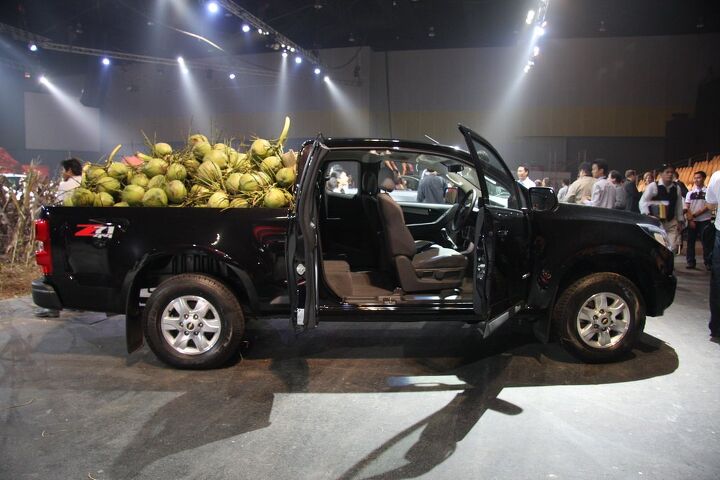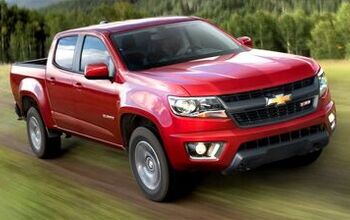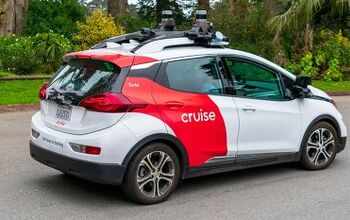Chevrolet Global Colorado Debuts In Thailand
Editor’s note: GM has officially confirmed what the UAW already let slip: Chevy’s new midsized Colorado pickup will be built at the Wentzville, MO plant and sold in the US. More details on that decision are forthcoming, but in the meantime, here’s Edd Ellison’s report from the global launch of the Colorado in Bangkok, Thailand.
Chevrolet has launched its new-generation Colorado in Thailand where it will be built and exported to 60 global markets. In true GM style, the ceremony was lavish – a cluster of truck ploughed their way through a large field of crops planted in a Bangkok exhibition hall watched by the media, dealers and VIPs packed into several grandstands – and the message was just as upbeat, the automaker feeling it has a product that can compete in the crowded mid-size segment.
In ten days time Thai customers will be able to pass judgment on whether GM have got this right, quickly followed by Malaysia, Indonesia and the Philippines. The New Colorado has to make up ground – the outgoing model, introduced seven years ago, never gained traction with consumers, particularly in the U.S. where robust initial sales tailed off very quickly. In the developing world, customers continued to prefer offerings from Toyota, Mitsubishi, Nissan and Isuzu – the latter somewhat ironically, as it shares its architecture with the Colorado.
GM is confident it has dotted all the ‘i’s and crossed the ‘t’s in developing the new Colorado. It has been a long and expensive project, involving the refitting of the Rayong factory, the construction of new engine plant next door to produce the new family of diesel engines, while styling was carried out in the carmaker’s Sao Paulo studios and extensive R&D was undertaken in Thailand and elsewhere. “It’s the most clean-sheet mid-size truck programme,” in GM history, said Martin Apfel, President GM Thailand/South East Asia.
According to Brad Merkel, GM Global Vehicle Line Executive, the big lesson which came from listening to customers was that they perceive pickups as “rough and tough” – but they don’t want “rough” to be a fundamental characteristic anymore, or even see why it should be. Growing aspirations and consumer demand that sees half of all pickups in Thailand bought as private cars has seen all OEMs scurrying to improve the comfort and luxury of their trucks. Toyota, the mid-size market leader, improved its Hilux this summer, and the others are following suit. Merkel says that the truck is now “refined” and points to the lack of vibrations, improved stability, and the dialing out of wind noise and rattles as key achievements. “It feels car-like,” he reckons.
The new Colorado will start from a low base here – 7,347 sales for the year to the end of August. That compares with 100,187 Hilux sales for tsunami-hit Toyota, 91,161 for the Colorado’s twin, Isuzu’s D-Max, 41,508 for Mitsubishi’s Triton and 16,032 for the Nissan Navara.
GM is anxious to emphasise the new project hasn’t been conducted in tandem with Isuzu, the two focusing on different directions after developing a common architecture. Addressing perceptions that the Colorado is more expensive to run has been a priority – the new model will go 20,000 km before its first scheduled service, while 100,000 km of running should be achieveable for a cost of no more than 20,000 baht.
Styling-wise, much of the design language has been carried over from the acclaimed Colorado “show truck” displayed at several major motor shows this year; however, some of that impact has been lost in the translation to production reality. The front end is dominated by Chevrolet’s twin-grille ‘family’ look which works quite well on what aims to be a big, butch pickup. It’s grown, too – the Colorado is now 5347mm long and there is a healthy choice of seven body colours. Inside the cabin is quite well laid out, but – as is to be expected with a pickup – there is a lot of hard plastic. The air-con controls are nicely laid out and backlit, there are umpteen storage areas and decent seats, but a number of areas, such as the instruments and door catches, feel basic and a bit clumsy.
The new four-cylinder diesel engines are based on the 6.6-litre V8 Duramax. They come in 2.5 and 2.8 litres and can be mated to 5-speed manual or 6-speed auto transmissions. The 2.5 (which should account for 75-80 percent of Thai sales) develops 150 HP and 350 Nm while the 2.8 has 180 HP on tap and 440 Nm (manual) or 470 Nm (auto).
Underneath, the body-on-frame chassis has been stiffened in torsion, and there are the expected safety features including front airbags, ESP, ABS, BA, CBC, HBFA and a deformable steering column.
GM is cautious about putting numbers on targets. The Rayong plant will assemble 12,000 new Colorados up to the end of this year, but management say they will be following demand. Capacity is likely to be around 100,000 units a year with a split between domestic and export. Only the 2.5 has been priced so far; it starts at 537,000 baht for the single cab, rising through extended/double cab, low/high ride and 2/4WD before reaching a range-topping 808,000 baht. That leaves the Colorado pretty much in line with existing pickup pricing here.
Edd Ellison is a Thailand-based auto journalist, covering the ASEAN markets and beyond. He can be contacted at edd@interfuture-media.com
More by Edd Ellison
Latest Car Reviews
Read moreLatest Product Reviews
Read moreRecent Comments
- Jeff Self driving cars are not ready for prime time.
- Lichtronamo Watch as the non-us based automakers shift more production to Mexico in the future.
- 28-Cars-Later " Electrek recently dug around in Tesla’s online parts catalog and found that the windshield costs a whopping $1,900 to replace.To be fair, that’s around what a Mercedes S-Class or Rivian windshield costs, but the Tesla’s glass is unique because of its shape. It’s also worth noting that most insurance plans have glass replacement options that can make the repair a low- or zero-cost issue. "Now I understand why my insurance is so high despite no claims for years and about 7,500 annual miles between three cars.
- AMcA My theory is that that when the Big 3 gave away the store to the UAW in the last contract, there was a side deal in which the UAW promised to go after the non-organized transplant plants. Even the UAW understands that if the wage differential gets too high it's gonna kill the golden goose.
- MKizzy Why else does range matter? Because in the EV advocate's dream scenario of a post-ICE future, the average multi-car household will find itself with more EVs in their garages and driveways than places to plug them in or the capacity to charge then all at once without significant electrical upgrades. Unless each vehicle has enough range to allow for multiple days without plugging in, fighting over charging access in multi-EV households will be right up there with finances for causes of domestic strife.











































Comments
Join the conversation
As long as there is not stupid 5-Cyl engine, it is an improvement. 5 cyl is pointless, GM has many very good V6s that are more powerful and efficient.
It has 6 thumbs up, apparently. I guess I don't mind it, but then again I don't need a truck of any sort. I'll agree that the current Chevy grille-treatment can go anytime. I know that Ford isn't much better (at least as it relates to big honking trucks), but something about Chevy's grilles of late have struck me wrong. It's almost like they're trying too hard to live up to their old slogan "Like A Rock", as in bang your head up against this thing to figure out why it needs to look this way, you'll feel better when you quit.